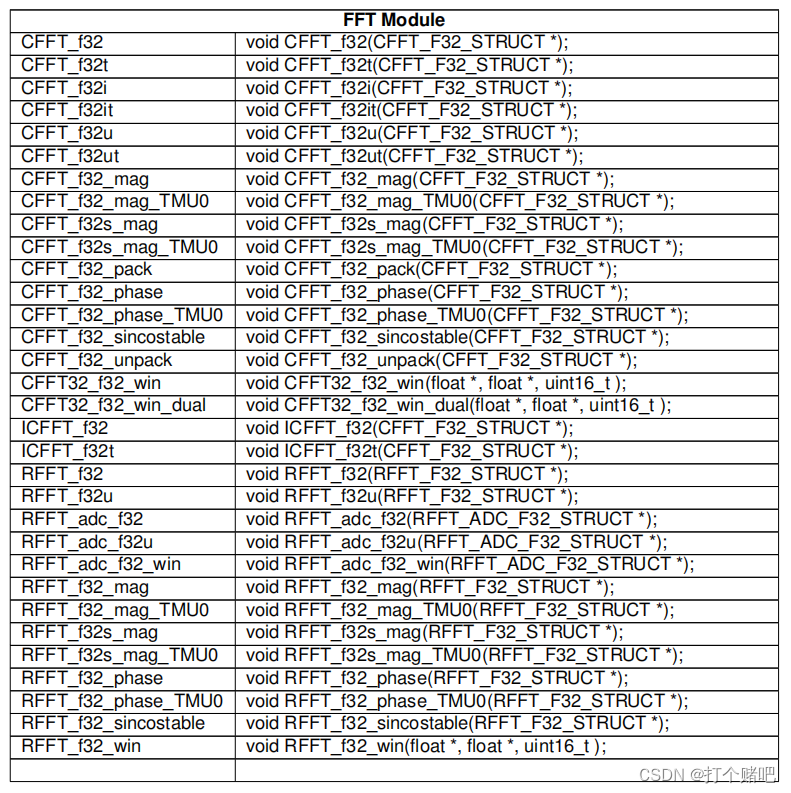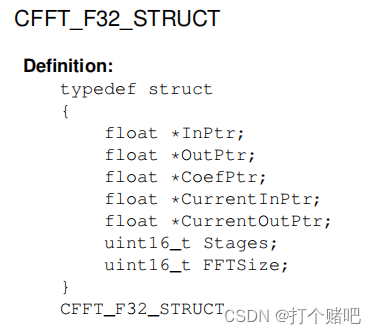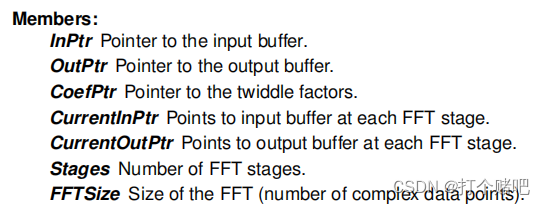德州仪器TMS320C28x浮点单元数字信号处理(FPU DSP)库是一个优化的信号处理例程的集合,为C2000设备编写,支持单精度浮点单元(FPU32),带有三角测量数学单元FPU32(TMU类型0),或双精度FPU(FPU64)。
这些功能使C/C++程序员能够充分利用上述硬件加速器来加快计算时间。FPU DSP Software Library usres guide提供了对库中包含的每个功能的描述。
其中5.4节介绍了实现复数FFT的模块
本文介绍用CFFT_f32()和CFFT_f32t()实现FFT的方法

1.数据结构
官方定义结构体CFFT_F32_STRUCT

结构体成员如下

IInPtr为指向输入缓冲区的指针
OutPtr为指向输出缓冲区的指针
CoefPtr为指向转化因子数组的指针
CurrentInPtr是指向每一阶输入数组的指针
CurrentOutPtr是指向每一阶输出数组的指针。
stage为傅里叶变换的阶数
FFTSize为FFT变换的长度,且有FFTSize=2^stage
2.函数void CFFT_f32 (CFFT_F32_STRUCT_Handle hndCFFT_F32)
该例程以乒乓的方式使用两个缓冲区,即在每个FFT阶段之后,输出和输入缓冲区分别成为下一阶段的输入和输出缓冲区。使用两个指针,CurrentInPtr和CurrentOutPtr来跟踪切换。用户可以通过查看CurrentOutPtr来确定最终输出的地址。
注意: 该例程要求使用两个缓冲区,每个缓冲区的大小为2N(32位float)以进行计算;输入缓冲区必须与4N个字(16位)的内存地址对齐。[^1]如果无法对齐,用户可以使用替代函数CFFT_f32u,尽管速度较慢。
这个函数不能重入,因为它使用全局变量来存储某些参数。
3.void CFFT_f32t (CFFT_F32_STRUCT_Handle hndCFFT_F32)
这个例程计算一个N-pt(N = 2^n,n = 5: 10)复数输入的32位浮点FFT。这个函数将在继续使用FFT之前以位反转的格式重新排序输入。该例程以乒乓的方式使用两个缓冲区,即在每个FFT阶段之后,输出和输入缓冲区分别成为下一阶段的输入和输出缓冲区。使用两个指针,CurrentInPtr和CurrentOutPtr来跟踪切换。用户可以通过查看CurrentOutPtr来确定最终输出的地址。
void CFFT_f32()和void CFFT_f32t()的区别是void CFFT_f32t()使用一个预先生成的旋转因子表。
注意:以上2和3的描述来自于FPU DSP Software Library usres guide。在运行例程的过程中发现用户手册与例程中的描述有出入。
4.例程
中文是我自己加的注释
#define CFFT_STAGES 7//7阶傅里叶变换
#define CFFT_SIZE (1 << CFFT_STAGES)
#define EPSILON 0.01
//*****************************************************************************
// globals
//*****************************************************************************
#ifdef __cplusplus
#pragma DATA_SECTION("CFFTdata1")//c++
#else
#pragma DATA_SECTION(CFFTin1Buff,"CFFTdata1")//c语言
#endif //__cplusplus
//! \brief FFT Calculation Buffer
//! \note The input buffer needs to be aligned to a 4N word boundary
//! \note If the number of FFT stages is odd, the result of the FFT will
//! be written to this buffer
//!
float CFFTin1Buff[CFFT_SIZE*2];//CFFTin1Buff是作为输入缓冲区//需要进行4字节对齐的操作//如果FFT的阶数是奇数,那么FFT的最终结果会写入此缓冲区
#ifdef __cplusplus
#pragma DATA_SECTION("CFFTdata2")
#else
#pragma DATA_SECTION(CFFTin2Buff,"CFFTdata2")
#endif //__cplusplus
//! \brief Magnitude Calculation Buffer//
//!
float CFFTin2Buff[CFFT_SIZE*2];
#ifdef __cplusplus
#pragma DATA_SECTION("CFFTdata3")
#else
#pragma DATA_SECTION(CFFToutBuff,"CFFTdata3")
#endif //__cplusplus
//! \brief FFT Calculation Buffer
//! \note If the number of FFT stages is even, the result of the FFT will
//! be written to this buffer//
//!
float CFFToutBuff[CFFT_SIZE*2];//CFFToutBuff是作为输出缓冲区//如果FFT的阶数是偶数,那么FFT的最终结果会写入此缓冲区
#ifdef __cplusplus
#pragma DATA_SECTION("CFFTdata4")
#else
#pragma DATA_SECTION(CFFTF32Coef,"CFFTdata4")
#endif //__cplusplus
//! \brief Twiddle Factors
//!
float CFFTF32Coef[CFFT_SIZE];//进行FFT计算所需要的旋转因子
float CFFTgoldenOut[CFFT_SIZE*2] = {//matlab计算fft的结果,用来与DSP的结果进行验证
#include "data_output_1.h"
};
float CFFTgoldenMagnitude[CFFT_SIZE] = {//matlab计算fft的幅值结果,用来与DSP的结果进行验证
#include "data_output_2.h"
};
float CFFTgoldenPhase[CFFT_SIZE] = {//matlab计算fft的相位结果,用来与DSP的结果进行验证
#include "data_output_3.h"
};
float RadStep = 0.1963495408494f;
float Rad = 0.0f;
//! \brief Object of the structure CFFT_F32_STRUCT
//!
CFFT_F32_STRUCT cfft;//官方定义结构体
//! \brief Handle to the CFFT_F32_STRUCT object
//!
CFFT_F32_STRUCT_Handle hnd_cfft = &cfft;
uint16_t pass = 0;
uint16_t fail = 0;
#ifdef USE_TABLES//如果用到预先生成的旋转因子表,需要进行下列操作
//Linker defined variables
extern uint16_t FFTTwiddlesRunStart;
extern uint16_t FFTTwiddlesLoadStart;
extern uint16_t FFTTwiddlesLoadSize;
#endif //USE_TABLES
//*****************************************************************************
// Function Prototypes
//*****************************************************************************
//*****************************************************************************
// function definitions
//*****************************************************************************
//!
//! \brief main routine for the Complex FFT example
//! \return returns a 1
//!
//! The test functions include CFFT_f32,CFFT_f32_mag and CFFT_f32_phase.
//! Data section alignment (#pragma ...) is not necessary for CFFT_f32u
//! but necessary for testing CFFT_f32.//在CMD文件中实现地址对齐
//!
//! Minimum CFFT_Stages is 3. When CFFT_Stages is more than 9, the
//! quantization error would be significant. The results can be compared
//! against MATLAB code under 2837x_CFFT/matlab/CFFTforC28xNew.
//!
//! CFFT_F32_STRUCT is a structure defined as:
//!
//! typedef struct {
//! float *InPtr;
//! float *OutPtr;
//! float *CoefPtr;
//! float *CurrentInPtr;
//! float *CurrentOutPtr;
//! short Stages;
//! uint16_t FFTSize;
//! }CFFT_F32_STRUCT;
//!
//! Watch Variables:
//!
//! -# InPtr Input/output or middle stage of ping-pong buffer
//! -# OutPtr Output or middle stage of ping-pong buffer
//! -# CurrentInPtr Output buffer for CFFT result
//! -# CurrentOutPtr N-1 stage CFFT result/Magnitude/Phase output buffer
//! -# CoefPtr Twiddle factor buffer
//!
//! ------------------------------------------------------------------------
//! | Stage 3 | Stage 4 |..| StageN(odd) | StageN(even)
//! ------------------------------------------------------------------------
//! InPtr(buf1) |CurrentInPtr |CurrentOutPtr|..|CurrentInPtr |CurrentOutPtr
//! ------------------------------------------------------------------------
//! OutPtr(buf2)|CurrentOutPtr|CurrentInPtr |..|CurrentOutPtr|CurrentInPtr
//! ------------------------------------------------------------------------
//! Result Buf | buf1 | buf2 |..| buf1 | buf2
//! ------------------------------------------------------------------------
//!可见CurrentInPtr和CurrentOutPtr是交替的,这就是FFT中用两个缓冲区buf1和buf2进行乒乓操作,当阶数stage为奇数时结果存储在buf1中,当阶数stage为偶数时结果存储在buf2中,
//! -# FFTSize must be a power of 2 (32, 64, 128, etc)
//! -# FFTSize must be greater or equal to 32
//! -# FFTStages must be log2(FFTSize)
//! -# InPtr, OutPtr, CoefPtr, CurrentInPtr, CurrentOutPtr are FFTSize*2 in
//! length.
//!
int16_t main(void)
{
// Locals
uint16_t i;
#ifdef FLASH
EALLOW;
Flash0EccRegs.ECC_ENABLE.bit.ENABLE = 0;
memcpy((uint32_t *)&RamfuncsRunStart, (uint32_t *)&RamfuncsLoadStart,
(uint32_t)&RamfuncsLoadSize );
FPU_initFlash();
#ifdef USE_TABLES//如果用到预先生成的旋转因子表,需要进行下列操作
memcpy((uint32_t *)&FFTTwiddlesRunStart, (uint32_t *)&FFTTwiddlesLoadStart,
(uint32_t)&FFTTwiddlesLoadSize );
#endif //USE_TABLES
#endif //FLASH
FPU_initSystemClocks();
FPU_initEpie();
// Clear input buffers:
for(i=0; i < (CFFT_SIZE*2); i=i+2){
CFFTin1Buff[i] = 0.0f;
CFFTin1Buff[i+1] = 0.0f;
CFFTin2Buff[i] = 0.0f;
CFFTin2Buff[i+1] = 0.0f;
CFFToutBuff[i] = 0.0f;
CFFToutBuff[i+1] = 0.0f;
}
// Generate sample waveforms://虚实交替存储
// CFFTin1Buff[0] = real[0]
// CFFTin1Buff[1] = imag[0]
// CFFTin1Buff[2] = real[1]
// 厖�
// CFFTin1Buff[N] = real[N/2]
// CFFTin1Buff[N+1] = imag[N/2]
// 厖�
// CFFTin1Buff[2N-3] = imag[N-2]
// CFFTin1Buff[2N-2] = real[N-1]
// CFFTin1Buff[2N-1] = imag[N-1]
Rad = 0.0f;
for(i=0; i < (CFFT_SIZE*2); i=i+2){
CFFTin1Buff[i] = sin(Rad) + cos(Rad*2.3567); // Real Part
CFFTin1Buff[i+1] = cos(Rad*8.345) + sin(Rad*5.789); // Imaginary Part
CFFTin2Buff[i] = CFFTin1Buff[i]; // Not used in calculation
CFFTin2Buff[i+1] = CFFTin1Buff[i+1]; // Not used in calculation
Rad = Rad + RadStep;
}
//
// Off-Place Algorithm异地算法
//
// Note: In this version, CFFTin1Buff and CFFToutBuff are used in
// ping-pong fashion. The input data is first stored in CFFTin1Buff
// where the FFT, including bit reversed ordering, is initially done.
// At each successive stage of the FFT the cfft.CurrentInPtr pointer
// will point to the buffer that is the input for that stage. In this
// manner the "CurrentInPtr" and "CurrentOutPtr" are exchanged at the
// start of each stage. Depending on the number of FFT stages, the
// final output will be in either CFFTin1Buff (#Stages is odd) or
// CFFToutBuff (#stages is even).
//注意:在此版本中,CFFTin1Buff和CFFToutBuff以乒乓球方式使用。输入数据首先存储在CFFTin1Buff中,其中FFT(包括位反向排序)最初完成。
//在FFT的每个连续阶段,CFFT。CurrentInPtr 指针将指向作为该阶段输入的缓冲区。通过这种方式,“CurrentInPtr”和“CurrentOutPtr”在每个阶段开始时交换。根据FFT级的数量,最终输出将以CFFTin1Buff(#Stages为奇数)或CFFToutBuff(#stages为偶数)为单位。
//Input/output or middle stage of ping-pong buffer
hnd_cfft->InPtr = CFFTin1Buff;
//Output or middle stage of ping-pong buffer
hnd_cfft->OutPtr = CFFToutBuff;
hnd_cfft->Stages = CFFT_STAGES; // FFT stages
hnd_cfft->FFTSize = CFFT_SIZE; // FFT size
#ifdef USE_TABLES//用预先生成的旋转因子表CFFT_f32_twiddleFactors
hnd_cfft->CoefPtr = CFFT_f32_twiddleFactors; //Twiddle factor table
#else//不用预先生成的旋转因子表而是用 CFFT_f32_sincostable(hnd_cfft)自己生成旋转因子表
hnd_cfft->CoefPtr = CFFTF32Coef; //Twiddle factor table
CFFT_f32_sincostable(hnd_cfft); // Calculate twiddle factor
#endif //USE_TABLES
//=========================================================================
// CFFT result:
// CurrentInPtr[0] = real[0]
// CurrentInPtr[1] = imag[0]
// CurrentInPtr[2] = real[1]
// 厖�
// CurrentInPtr[N] = real[N/2]
// CurrentInPtr[N+1] = imag[N/2]
// 厖�
// CurrentInPtr[2N-3] = imag[N-2]
// CurrentInPtr[2N-2] = real[N-1]
// CurrentInPtr[2N-1] = imag[N-1]
//
//=========================================================================
#ifdef USE_TABLES
CFFT_f32t(hnd_cfft); // Calculate FFT//计算FFT
#else
CFFT_f32(hnd_cfft); // Calculate FFT
#endif //USE_TABLES
// Check the output//CFFTgoldenOut是matlab计算结果的存储区、hnd_cfft->CurrentInPtr是DSP计算结果的存储区、
for(i = 0; i < 2*CFFT_SIZE; i++){
if(fabs(CFFTgoldenOut[i] - hnd_cfft->CurrentInPtr[i]) <= EPSILON){
pass++;
}else{
fail++;
}
}
//
// Note: The input buffer for the magnitude calculation is pointed to by
// cfft.CurrentInPtr, while the output is stored in the memory
// pointed to by cfft.CurrentOutPtr. If the user does not changed
// the value of cfft.CurrentOutPtr after calling the magnitude
// calculation function, the output buffer is overwritten when the
// phase calculation function is called
//幅度计算的输入缓冲区由 cfft.CurrentInPtr指向,而输出存储在cfft.CurrentOutPtr指向的内存中。如果用户未更改 cfft 的值。CurrentOutPtr 调用幅度计算函数后,调用相位计算函数时覆盖输出缓冲器
// If number of Stages is ODD, 如果FFT阶数为奇数
// currentInPtr=CFFTin1Buff, currentOutPtr=CFFToutBuff
// If number of Stages is EVEN,
// currentInPtr=CFFToutBuff, currentOutPtr=CFFTin1Buff
//
// Calculate Magnitude:
#ifdef __TMS320C28XX_TMU__ //defined when --tmu_support=tmu0 in the project properties
//project properties查看tmu_support
// Calculate magnitude, result stored in CurrentOutPtr
CFFT_f32_mag_TMU0(hnd_cfft);
#else
// Calculate magnitude, result stored in CurrentOutPtr
CFFT_f32_mag(hnd_cfft);
#endif
// Check the output
for(i = 0; i < CFFT_SIZE; i++){
if(fabs(CFFTgoldenMagnitude[i] - hnd_cfft->CurrentOutPtr[i]) <=
EPSILON){
pass++;
}else{
fail++;
}
}
// Magnitude Result:
// CurrentOutPtr[0] = Mag[0]
// CurrentOutPtr[1] = Mag[1]
// CurrentOutPtr[2] = Mag[2]
// 厖�
// CurrentOutPtr[N-1] = Mag[N-1]
// Calculate Phase:
// To avoid overwriting the magnitude, change the output buffer for
// the phase()
hnd_cfft->CurrentOutPtr=CFFTin2Buff;
#ifdef __TMS320C28XX_TMU__ //defined when --tmu_support=tmu0 in the project
//properties
// Calculate phase, result stored in CurrentOutPtr
CFFT_f32_phase_TMU0(hnd_cfft);
#else
// Calculate phase, result stored in CurrentOutPtr
CFFT_f32_phase(hnd_cfft);
#endif
// Check the output
for(i = 0; i < CFFT_SIZE; i++){
if(fabs(CFFTgoldenPhase[i] - hnd_cfft->CurrentOutPtr[i]) <= EPSILON){
pass++;
}else{
fail++;
}
}
// Phase Result:
// CurrentOutPtr[0] = Phase[0]
// CurrentOutPtr[1] = Phase[1]
// CurrentOutPtr[2] = Phase[2]
// 厖�
// CurrentOutPtr[N-1] = Phase[N-1]
// End of test
done();
// Execution never reaches this point
return 1;
}
以上是CFFT_f32_sincostable、CFFT_f32t(hnd_cfft)、CFFT_f32(hnd_cfft)、CFFT_f32_mag_TMU0(hnd_cfft)、CFFT_f32_mag(hnd_cfft)、CFFT_f32_phase_TMU0(hnd_cfft)、CFFT_f32_phase(hnd_cfft)几个库函数用法的例程
例程中运行的结果与例程的注释相符合

假设起初buf1为输入缓冲区,其地址由InPtr指向,buf2为输出缓冲区,其地址由OutPtr指向。则调用CFFT_f32t(hnd_cfft)或CFFT_f32(hnd_cfft)函数后:
如果FFT阶数为奇数,FFT的结果保存在输入缓冲区buf1中,其地址由InPtr和CurrentInPtr指向。
如果FFT阶数为偶数,FFT的结果保存在输入缓冲区buf2中,其地址由OutPtr和CurrentInPtr指向。
5.数据对齐
在cmd文件中实现了数据对齐
 FFT阶数为7,所以做了N=2^7=128点的FFT,对于4N对齐应当使CFFT_ALIGNMENT=4*N=512。
FFT阶数为7,所以做了N=2^7=128点的FFT,对于4N对齐应当使CFFT_ALIGNMENT=4*N=512。
6.关于#ifdef __ TMS320C28XX_TMU __
可以project properties查看tmu_support

在其中选择tmu0
结论:
假设起初buf1为输入缓冲区,其地址由InPtr指向,buf2为输出缓冲区,其地址由OutPtr指向。则调用CFFT_f32t(hnd_cfft)或CFFT_f32(hnd_cfft)函数后:
如果FFT阶数为奇数,FFT的结果保存在输入缓冲区buf1中,其地址由InPtr和CurrentInPtr指向。
如果FFT阶数为偶数,FFT的结果保存在输入缓冲区buf2中,其地址由OutPtr和CurrentInPtr指向。
于 2023-05-15 第一次整理编写
学习时整理,不当之处烦请指正
码字不易,留个赞再走吧
























 2856
2856











 被折叠的 条评论
为什么被折叠?
被折叠的 条评论
为什么被折叠?








